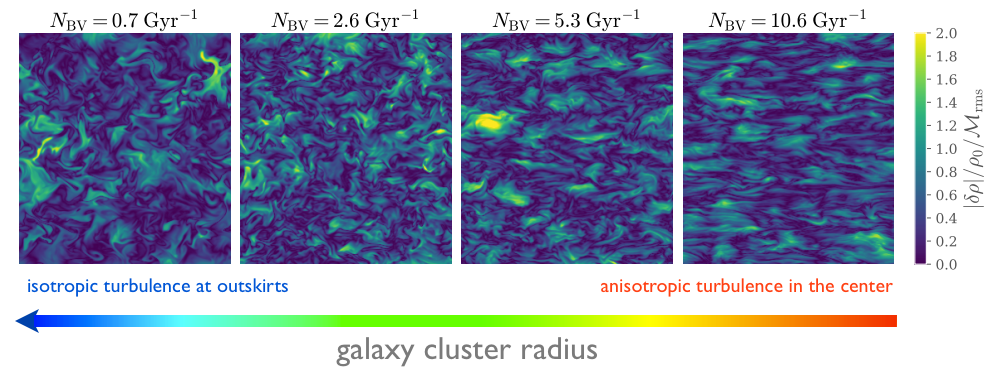云南大学中国西南天文研究所研究团队数值模拟揭示了密度分层对星系团中湍流演化的影响
Numerical simulations reveal how density stratification influences the evolution of intracluster turbulence
湍流在我们周围无处不在,它也存在于星系团内的介质中。所谓的“星系团内介质”(ICM)中的湍流运动在许多天体物理过程中发挥着重要作用,例如AGN反馈,化学物质的分布和磁场的产生。它们还是星系团非热压强的主要来源,使基于流体静力平衡的星系团质量估计值产生偏差,因此研究ICM湍流也是使用星系团研究精密宇宙学的重要课题。星系团内湍流的一个难以理解的特性是它对半径的依赖性:通常,在星系团外区比在中心区域有着更强的湍流运动。无论是在ICM中产生湍流的天体过程,还是湍流的经典Kolmogorov理论,都无法解释这种对半径的依赖性。 SWIFAR科学家石洵提出,这种径向依赖性是由不同半径的ICM密度分层的不同程度引起的湍流演化时标的径向依赖。她同合作者进行了ICM湍流演化的计算机模拟以验证这一想法。他们的结果表明,在中心区域ICM湍流受密度分层的影响较强,并且可以演化成水平方向延展而垂直方向狭窄的各向异性湍流。相反,外区的湍流受密度分层的影响不大,并且在整个演化过程中保持各向同性(见图)。存在密度分层时,在浮力作用下湍流的动能与引力势能之间可以进行能量转化。这一新的能量通道可能使得对半径依赖的浮力时标成为ICM湍流演化的决定性时标。
该研究成果已发表于《皇家天文学月刊》(Monthly Notices of the Royal Astronomical Society,文章链接: https://ui.adsabs.harvard.edu/abs/2019MNRAS.487.1072S/abstract)。

图1: 通过X射线观测可知星系团内介质存在密度分层(左图:Coma星系团的X射线观测),就好比地球大气中密度分层的平流层(右图)。Intracluster medium is density-stratified as shown by X-ray observations (left panel: X-ray image of the Coma Galaxy Cluster), so that the intracluster medium shares similarity with the Earth's stratosphere (right panel).

图2: 数值模拟发现星系团中湍流演化对半径有依赖:它在密度分层较强的内区变得各向异性,而在密度分层较弱的外区保持各向同性。Simulations show that intracluster turbulence evolves differently at different regions: turbulence becomes anisotropic in the strongly stratified central regions and remains isotropic in the weakly stratified outskirts.

Turbulence is everywhere around us, and also in the medium inside clusters of galaxies. Turbulent motions in the so-called 'intracluster medium' (ICM) play an important role in many astrophysical processes such as AGN feedback, distribution of chemicals, and generation of magnetic fields. They also provide non-thermal pressure that biases the cluster mass estimate based on hydrostatic equilibrium, and thus are an important topic in precision cosmology using galaxy clusters. One intriguing aspect of the intracluster turbulence is its dependence on the radius: typically, there are more turbulent motions in the outskirts of galaxy clusters than in the central regions. This radial dependence is expected neither from the astrophysical processes that generate turbulence in the ICM nor from the classical Kolmogorov theory of isotropic, homogeneous turbulence. SWIFAR scientist Xun Shi proposed that the cause of this radial dependence is a radial-dependent turbulence evolution time caused by varying degrees of density stratification of the ICM at different radii. With a collaborator of hers, she performed computer simulations of turbulence evolution in the ICM to investigate this idea. Their results show that ICM turbulence is strongly influenced by the density stratification in the central regions, and can evolve into anisotropic turbulence composing of layered eddies extended in the horizontal direction but narrow in the vertical direction. In contrast, turbulence at cluster outskirts is not much affected by density stratification and remains isotropic throughout its evolution (see Figure). With density stratification, a new channel of energy flow between the kinetic and the potential energy is opened up by buoyancy, and the radial dependent buoyancy time scale is likely the decisive time scale in ICM turbulence evolution. These results have been published in Monthly Notices of the Royal Astronomical Society (article link: https://ui.adsabs.harvard.edu/abs/2019MNRAS.487.1072S/abstract).
